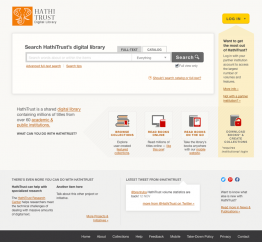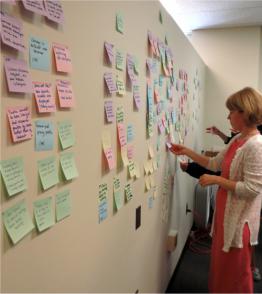Here are two success stories about user experience departments in academic libraries: The University of Michigan and Georgia Tech.
The University of Michigan
Part of the Library Information Technology Unit (LIT), the User Experience Department at The University of Michigan supports the library’s primary user interfaces, including the MLibrary website, the catalog (Mirlyn), the MLibrary mobile interfaces, digital library collections, and the HathiTrust Digital Library. They focus their efforts on interface design (interaction and visual design), user research, assessment (usability, web use statistics analysis), content management and strategy, and web accessibility.
Below are three of their selected projects, of which there several on their website:
Improving the Library’s Website
Starting in July 2013, after hiring a Web Content Strategist and UX Designer, the UX Department began a concerted improvement of the library’s web ecosystem. They have empowered a group of web content coordinators from divisions across the library and are working closely with them on projects large and small. A few of their efforts include – rolling out an expanded web presence for collections, launching a blogging platform for the library, improving the library gateway by adding quick links, frequently used databases and spotlight features, and retired quite a bit of outdated and duplicated content.
HathiTrust Digital Library – Regular & Mobile Interface Design
The HathiTrust Digital Library is a multi-institutional repository of digitized materials that provides access to over 10 million books & journals (over 2.6 million public domain and fully viewable) with a search across full text of all volumes, and ability to create and share collections.
The UX Department designed and developed a mobile version (m.hathitrust.org) in 2012 and completed a full redesign of the system in Winter 2013.
User Experience Research
 User research is an important part of the design and problem-solving process. The UX team utilizes a variety of methods including surveys, “guerrila” usability, interviews, and remote observations to better understand user needs, perceptions, and behavior. They will occasionally share their studies along with those done as collaboration with special projects and committees.
User research is an important part of the design and problem-solving process. The UX team utilizes a variety of methods including surveys, “guerrila” usability, interviews, and remote observations to better understand user needs, perceptions, and behavior. They will occasionally share their studies along with those done as collaboration with special projects and committees.
Georgia Tech
The Georgia Tech User Experience department focuses their efforts in three main areas:
- User Engagement and Assessment
- External and Campus Communications
- Collaborative Outreach with Library and Campus Partners
They aim to continually communicate with users, assess the library’s services and ultimately work with colleagues to improve the user’s experience. Georgia Tech UX has collaborated with internal and external partners in order to maintain open channels of two-way communication. Members of the UX department are involved with many of these user engagement initiatives including: serving on or managing advisory boards, conducting surveys, consulting on space redesign, monitoring and responding to social media, and coordinating focus groups.
The UX department has helped centralize external communications from the library to other campus outlets through print and digital signage, social media, campus publications, email campaigns, and national media. The goal is to promote library resources, services and events in a consistent, content-rich and strategic manner.
The UX department has also collaborated with internal and external partners on outreach initiatives. More detail about those can be found on their website.
*Featured image from The University of Michigan User Experience Department.
References:
U-M Library, User Experience Department, University of Michigan.
Georgia Tech Library, User Experience, Georgia Tech.